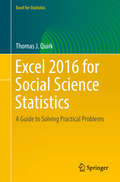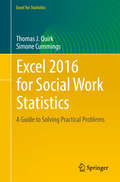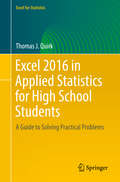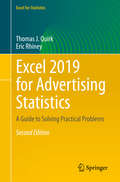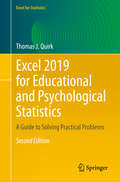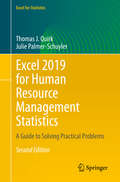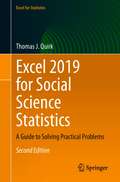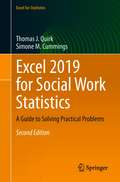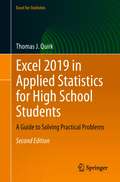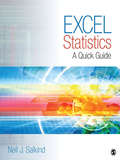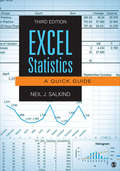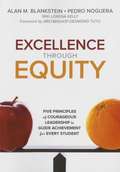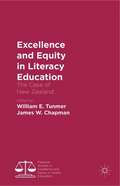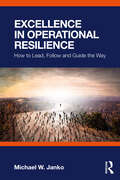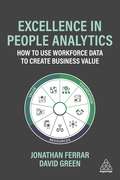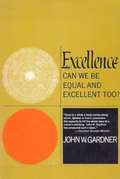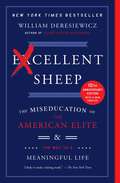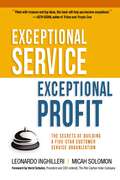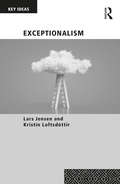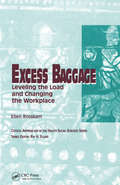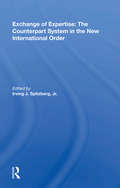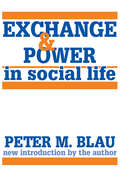- Table View
- List View
Excel 2016 for Social Science Statistics
by Thomas J QuirkThis book shows the capabilities of Microsoft Excel in teaching social science statistics effectively. Similar to the previously published Excel 2013 for Social Sciences Statistics, this book is a step-by-step exercise-driven guide for students and practitioners who need to master Excel to solve practical social science problems. If understanding statistics isn’t your strongest suit, you are not especially mathematically-inclined, or if you are wary of computers, this is the right book for you.<P><P> Excel, a widely available computer program for students and managers, is also an effective teaching and learning tool for quantitative analyses in social science courses. Its powerful computational ability and graphical functions make learning statistics much easier than in years past. However, Excel 2016 for Social Science Statistics: A Guide to Solving Practical Problems is the first book to capitalize on these improvements by teaching students and managers how to apply Excel to statistical techniques necessary in their courses and work.<P> Each chapter explains statistical formulas and directs the reader to use Excel commands to solve specific, easy-to-understand social science problems. Practice problems are provided at the end of each chapter with their solutions in an appendix. Separately, there is a full Practice Test (with answers in an Appendix) that allows readers to test what they have learned.
Excel 2016 for Social Work Statistics
by Thomas J. Quirk Simone CummingsThis text is a step-by-step guide for students taking a first course in statistics for social work and for social work managers and practitioners who want to learn how to use Excel to solve practical statistics problems in in the workplace, whether or not they have taken a course in statistics. There is no other text for a first course in social work statistics that teaches students, step-by-step, how to use Excel to solve interesting social work statistics problems. Excel 2016 for Social Work Statistics explains statistical formulas and offers practical examples for how students can solve real-world social work statistics problems. This book leaves detailed explanations of statistical theory to other statistics textbooks and focuses entirely on practical, real-world problem solving. Each chapter briefly explains a topic and then demonstrates how to use Excel commands and formulas to solve specific social work statistics problems. This book gives practice in using Excel in two different ways: (1) writing formulas (e. g. , confidence interval about the mean, one-group t-test, two-group t-test, correlation) and (2) using Excel's drop-down formula menus so as not to have to write formulas (e. g. , simple linear regression, multiple correlation and multiple regression, and one-way ANOVA). Three practice problems are provided at the end of each chapter, along with their solutions in an Appendix. An additional Practice Test allows readers to test their understanding of each chapter by attempting to solve a specific practical social work statistics problem using Excel; the solution to each of these problems is also given in an Appendix.
Excel 2016 in Applied Statistics for High School Students: A Guide To Solving Practical Problems (Excel For Statistics Ser.)
by Thomas J. QuirkThis textbook is a step-by-step guide for high school, community college, or undergraduate students who are taking a course in applied statistics and wish to learn how to use Excel to solve statistical problems. All of the statistics problems in this book will come from the following fields of study: business, education, psychology, marketing, engineering and advertising. Students will learn how to perform key statistical tests in Excel without being overwhelmed by statistical theory. Each chapter briefly explains a topic and then demonstrates how to use Excel commands and formulas to solve specific statistics problems. This book gives practice in using Excel in two different ways: (1) writing formulas (e.g., confidence interval about the mean, one-group t-test, two-group t-test, correlation) and (2) using Excel’s drop-down formula menus (e.g., simple linear regression, multiple correlations and multiple regression, and one-way ANOVA). Three practice problems are provided at the end of each chapter, along with their solutions in an Appendix. An additional Practice Test allows readers to test their understanding of each chapter by attempting to solve a specific statistics problem using Excel; the solution to each of these problems is also given in an Appendix. This book is a tool that can be used either by itself or along with any good statistics book. Includes 166 illustrations in color Suitable for high school and community college students.
Excel 2019 for Advertising Statistics: A Guide to Solving Practical Problems (Excel for Statistics)
by Thomas J. Quirk Eric RhineyNewly revised for Excel 2019, this text is a step-by-step guide for students taking a first course in statistics for advertising and for advertising managers and practitioners who want to learn how to use Excel to solve practical statistics problems in the workplace, whether or not they have taken a course in statistics.Excel 2019 for Advertising Statistics explains statistical formulas and offers practical examples for how students can solve real-world advertising statistics problems. Each chapter offers a concise overview of a topic, and then demonstrates how to use Excel commands and formulas to solve specific advertising statistics problems. This book demonstrates how to use Excel 2019 in two different ways: (1) writing formulas (e.g., confidence interval about the mean, one-group t-test, two-group t-test, correlation) and (2) using Excel’s drop-down formula menus (e.g., simple linear regression, multiple correlation and multiple regression, and one-way ANOVA). Three practice problems are provided at the end of each chapter, along with their solutions in an appendix. An additional practice test allows readers to test their understanding of each chapter by attempting to solve a specific practical advertising statistics problem using Excel; the solution to each of these problems is also given in an appendix. This latest edition features a wealth of new end-of-chapter problems and an update of the chapter content throughout.
Excel 2019 for Educational and Psychological Statistics: A Guide to Solving Practical Problems (Excel for Statistics)
by Thomas J. QuirkNewly revised to specifically address Microsoft Excel 2019, this book shows the capabilities of Excel in teaching educational and psychological statistics effectively. Similar to the previously published Excel 2016 for Educational and Psychological Statistics, it is a step-by-step, exercise-driven guide for students and practitioners who need to master Excel to solve practical education and psychology problems.Excel, a widely available computer program for students and managers, is also an effective teaching and learning tool for quantitative analyses in education and psychology courses. Its powerful computational ability and graphical functions make learning statistics much easier than in years past. Excel 2019 for Educational and Psychological Statistics capitalizes on these improvements by teaching students and managers how to apply Excel to statistical techniques necessary in their courses and work.Each chapter explains statistical formulas and directs the reader to use Excel commands to solve specific, easy-to-understand educational and psychological problems. Practice problems are provided at the end of each chapter with their solutions in an appendix. Separately, there is a full practice test (with answers in an appendix) that allows readers to test what they have learned. This new edition features a wealth of new chapter problems and solutions, as well as updated chapter content throughout.
Excel 2019 for Human Resource Management Statistics: A Guide to Solving Practical Problems (Excel for Statistics)
by Thomas J. Quirk Julie Palmer-SchuylerThis book shows the capabilities of Microsoft Excel in teaching human resource management statistics effectively. Similar to the previously published Excel 2016 for Human Resource Management Statistics, this book is a step-by-step, exercise-driven guide for students and practitioners who need to master Excel to solve practical human resource management problems. If understanding statistics isn’t your strongest suit, you are not especially mathematically inclined, or if you are wary of computers, this is the right book for you. Excel, a widely available computer program for students and managers, is also an effective teaching and learning tool for quantitative analyses in human resource management courses. Its powerful computational ability and graphical functions make learning statistics much easier than in years past. However, Excel 2019 for Human Resource Management Statistics: A Guide to Solving Practical Problems, 2nd Edition, capitalizes on these improvements by teaching students and managers how to apply Excel to statistical techniques necessary in their courses and work. Each chapter explains statistical formulas and directs the reader to use Excel commands to solve specific, easy-to-understand human resource management problems. Practice problems are provided at the end of each chapter with their solutions in an appendix. Separately, there is a full practice test (with answers in an appendix) that allows readers to test what they have learned.
Excel 2019 for Social Science Statistics: A Guide to Solving Practical Problems (Excel for Statistics)
by Thomas J. QuirkThis book shows the capabilities of Microsoft Excel in teaching social science statistics effectively. Similar to the previously published Excel 2016 for Social Sciences Statistics, this book is a step-by-step, exercise-driven guide for students and practitioners who need to master Excel to solve practical social science problems. If understanding statistics isn’t your strongest suit, you are not especially mathematically inclined, or you are wary of computers, this is the right book for you.Excel, a widely available computer program for students and managers, is also an effective teaching and learning tool for quantitative analyses in social science courses. Its powerful computational ability and graphical functions make learning statistics much easier than in years past. Excel 2019 for Social Science Statistics: A Guide to Solving Practical Problems capitalizes on these improvements by teaching students and managers how to apply Excel to statistical techniques necessary in their courses and work.In this new edition, each chapter explains statistical formulas and directs the reader to use Excel commands to solve specific, easy-to-understand social science problems. Practice problems are provided at the end of each chapter with their solutions in an appendix. Separately, there is a full practice test (with answers in an appendix) that allows readers to test what they have learned.
Excel 2019 for Social Work Statistics: A Guide to Solving Practical Problems (Excel for Statistics)
by Thomas J. Quirk Simone M. CummingsThis text is a step-by-step, exercise-driven guide for students and practitioners who need to master Excel to solve practical social work problems. If understanding statistics isn’t your strongest suit, you are not especially mathematically inclined, or if you are wary of computers, this is the right book for you. Excel, a widely available computer program for students and managers, is also an effective teaching and learning tool for quantitative analyses in social work courses. Its powerful computational ability and graphical functions make learning statistics much easier than in years past. Excel 2019 for Social Work Statistics: A Guide to Solving Practical Problems capitalizes on these improvements by teaching students and managers how to apply Excel to statistical techniques necessary in their courses and work. In this new edition, each chapter explains statistical formulas and directs the reader to use Excel commands to solve specific, easy-to-understand social work problems. Practice problems are provided at the end of each chapter with their solutions in an Appendix. Separately, there is a full Practice Test (with answers in an Appendix) that allows readers to test what they have learned.
Excel 2019 in Applied Statistics for High School Students: A Guide to Solving Practical Problems (Excel for Statistics)
by Thomas J. QuirkThis textbook is a step-by-step guide for high school, community college, and undergraduate students who are taking a course in applied statistics and wish to learn how to use Excel to solve statistical problems. All of the statistics problems in this book come from the following fields of study: business, education, psychology, marketing, engineering and advertising. Students will learn how to perform key statistical tests in Excel without being overwhelmed by statistical theory. Each chapter briefly explains a topic and then demonstrates how to use Excel commands and formulas to solve specific statistics problems. The book offers guidance in using Excel in two different ways: (1) writing formulas (e.g., confidence interval about the mean, one-group t-test, two-group t-test, correlation) and (2) using Excel’s drop-down formula menus (e.g., simple linear regression, multiple correlations and multiple regression, and one-way ANOVA). Three practice problems are provided at the end of each chapter, along with their solutions in an appendix. An additional practice test allows readers to test their understanding of each chapter by attempting to solve a specific statistics problem using Excel; the solution to each of these problems is also given in an appendix. This book is a tool that can be used either by itself or along with any good statistics book.
Excel Statistics: A Quick Guide
by Neil J. SalkindBecome a pro at using Excel for statistical analysis! Designed for users already familiar with basic computer operations, Neil J. Salkind's Excel Statistics: A Quick Guide shows readers how to utilize the features of Microsoft Excel to answer both simple and complex questions about data analysis. Excel novices and experts alike will find this text not only practical but easy to use and engaging.
Excel Statistics: A Quick Guide
by Neil J. SalkindIdeal for those already familiar with basic Excel features, this updated Third Edition of Neil J. Salkind’s Excel Statistics: A Quick Guide shows readers how to utilize Microsoft® Excel’s functions and Analysis ToolPak to answer simple and complex questions about data. Part I explores 35 Excel functions, while Part II contains 20 Analysis ToolPak tools. To make it easy to see what each function or tool looks like when applied, at-a-glance two-page spreads describe each function and its use with corresponding screenshots. In addition, actual data files used in the examples are readily available online at an open-access Student Study Site.
Excel Statistics: A Quick Guide
by Neil J. SalkindIdeal for those already familiar with basic Excel features, this updated Third Edition of Neil J. Salkind’s Excel Statistics: A Quick Guide shows readers how to utilize Microsoft® Excel’s functions and Analysis ToolPak to answer simple and complex questions about data. Part I explores 35 Excel functions, while Part II contains 20 Analysis ToolPak tools. To make it easy to see what each function or tool looks like when applied, at-a-glance two-page spreads describe each function and its use with corresponding screenshots. In addition, actual data files used in the examples are readily available online at an open-access Student Study Site.
Excellence Through Equity
by Pedro Noguera Alan M. BlanksteinCourageous, inspiring examples of educational equity in action! This illuminating book builds the case that equity is the most powerful means we have to lift all children to higher achievement and to benefit society at large. Readers will find: Examples of high-leverage practices used by award-winning schools and districts System-level examples of excellence through equity including whole state and district-wide Examples of classroom level practice that lead to success for students from underserved populations as well as for their more privileged peers A powerful concluding chapter that focuses on what we can learn from other nations that have pursued the goals of educational equity
Excellence and Equity in Literacy Education
by William E. Tunmer James W. ChapmanLiteracy is arguably the most important goal of schooling as, to a large extent, it determines young children's educational and life chances and is fundamental in achieving social justice. New Zealand's literacy education programme has long been regarded as one of the world's most successful approaches to teaching literacy skills to young children. Excellence and Equity in Literacy Education questions this widely held assumption. In the late 1990s the New Zealand government developed a national literacy strategy aimed at reducing persistently large inequities in literacy achievement outcomes. The chapters in this edited volume present evidence indicating that the national literacy strategy has failed, examine the major factors responsible for the continuation of New Zealand's comparatively wide spread of scores in literacy achievement, and describe the most effective strategies for reducing the literacy achievement gap and achieving excellence and equity in New Zealand literacy education.
Excellence in Operational Resilience: How to Lead, Follow and Guide the Way
by Michael W. JankoProviding essential guidance to thrive in a complex environment, this book showcases tools to take the leadership role in the process of building resilience in any organization in a timely, effective, and practical way for today’s risks and tomorrow’s challenges.All organizations seek to be resilient, yet most do not have a clear definition of what that means for them, or a plan to manage the journey to attain it. This resilience playbook includes the right combination of technical knowledge, team structure, leadership support, and behavioral competencies, all based on a clear “Lead, Follow, Guide” framework. Based on the author’s three decades of successfully implementing resilience-based strategies at Goodyear and other major firms, this book offers road-tested advice and techniques to bring quick wins and long-term success in organizational resilience.With this book to assist, risk-savvy executive leaders and professionals working in business continuity, risk management, security, IT, supply chain, operations management, and process improvement will maintain a constant pulse on their journey towards resilience, keep the right people engaged, and create a team-based approach to reach their goals.
Excellence in People Analytics: How to Use Workforce Data to Create Business Value
by David Green Jonathan FerrarEffectively and ethically leveraging people data to deliver real business value is what sets the best HR leaders and teams apart. Excellence in People Analytics provides business and human resources leaders with everything they need to know about creating value from people analytics.Written by two leading experts in the field, this practical guide outlines how to create sustainable business value with people analytics and develop a data-driven culture in HR. Most importantly, it allows HR professionals and business executives to translate their data into tangible actions to improve business performance. while navigating the rapidly evolving world of work. Full of practical tools and advice assembled around the Insight222 Nine Dimensions in People Analytics® model, this book demonstrates how to use people data to increase profits, improve staff retention and workplace productivity as well as develop individual employee experience. Featuring case studies from leading companies including Microsoft, HSBC, Syngenta, Capital One, Novartis, Bosch, Uber, Santander Brasil and American Eagle Outfitters®, Excellence in People Analytics is essential reading for all HR professionals needing to unlock the potential in their people data and gain competitive advantage
Excellence: Can We Be Equal And Excellent Too?
by Dr John W. GardnerThis is a book about excellence, more particularly about the conditions under which excellence is possible in our kind of society; but it is also--inevitably--a book about equality, about the kinds of equality that can and must be honored, and the kinds that cannot be forced.Such a book must raise some questions which Americans have shown little inclination to discuss rationally.What are the characteristic difficulties a democracy encounters in pursuing excellence? Is there a way out of these difficulties?How equal do we want to be? How equal can we be?What do we mean when we say, "Let the best man win"? Can an equalitarian society tolerate winners?Are we overproducing highly educated people? How much talent can the society absorb? Does society owe a living to talent? Does talent invariably have a chance to exhibit itself in our society?Does every young American have a "right" to a college education?Are we headed toward domination by an intellectual elite?Is it possible for a people to achieve excellence if they don't believe in anything? Have the American people lost their sense of purpose and the drive which would make it possible for them to achieve excellence?
Excellent Sheep: The Miseducation of the American Elite and the Way to a Meaningful Life
by William DeresiewiczA groundbreaking manifesto about what our nation&’s top schools should be—but aren&’t—providing: &“The ex-Yale professor effectively skewers elite colleges, their brainy but soulless students (those &‘sheep&’), pushy parents, and admissions mayhem&” (People).As a professor at Yale, William Deresiewicz saw something that troubled him deeply. His students, some of the nation&’s brightest minds, were adrift when it came to the big questions: how to think critically and creatively and how to find a sense of purpose. Now he argues that elite colleges are turning out conformists without a compass. Excellent Sheep takes a sharp look at the high-pressure conveyor belt that begins with parents and counselors who demand perfect grades and culminates in the skewed applications Deresiewicz saw firsthand as a member of Yale&’s admissions committee. As schools shift focus from the humanities to &“practical&” subjects like economics, students are losing the ability to think independently. It is essential, says Deresiewicz, that college be a time for self-discovery when students can establish their own values and measures of success in order to forge their own paths. He features quotes from real students and graduates he has corresponded with over the years, candidly exposing where the system is broken and offering clear solutions on how to fix it. &“Excellent Sheep is likely to make…a lasting mark….He takes aim at just about the entirety of upper-middle-class life in America….Mr. Deresiewicz&’s book is packed full of what he wants more of in American life: passionate weirdness&” (The New York Times).
Exceptional America: What Divides Americans from the World and from Each Other
by Mugambi JouetWhy did Donald Trump follow Barack Obama into the White House? Why is America so polarized? And how does American exceptionalism explain these social changes? In this provocative book, Mugambi Jouet describes why Americans are far more divided than other Westerners over basic issues, including wealth inequality, health care, climate change, evolution, gender roles, abortion, gay rights, sex, gun control, mass incarceration, the death penalty, torture, human rights, and war. Raised in Paris by a French mother and Kenyan father, Jouet then lived in the Bible Belt, Manhattan, and beyond. Drawing inspiration from Alexis de Tocqueville, he wields his multicultural sensibility to parse how the intense polarization of U.S. conservatives and liberals has become a key dimension of American exceptionalism—an idea widely misunderstood as American superiority. While exceptionalism once was a source of strength, it may now spell decline, as unique features of U.S. history, politics, law, culture, religion, and race relations foster grave conflicts. They also shed light on the intriguing ideological evolution of American conservatism, which long predated Trumpism. Anti-intellectualism, conspiracy-mongering, a visceral suspicion of government, and Christian fundamentalism are far more common in America than the rest of the Western world—Europe, Canada, Australia, and New Zealand. Exceptional America dissects the American soul, in all of its peculiar, clashing, and striking manifestations.
Exceptional Service, Exceptional Profit: The Secrets of Building a Five-Star Customer Service Organization
by Micah Solomon Leonardo InghilleriWhat if you could protect your business against competitive inroads, once and for all?Customer service experts Leonardo Inghilleri and Micah Solomon's anticipatory customer service approach was first developed at The Ritz-Carlton as well as at Solomon's company Oasis, and has since proven itself in countless companies around the globe--from luxury giant BVLGARI to value-sensitive auto parts leader Carquest and everywhere in between.Their experience shows that the most powerful growth engine in a tight market--and best protection from competitive inroads--is to put everything you can into cultivating true customer loyalty. Exceptional Service, Exceptional Profit takes the techniques that minted money for these brands and reveals how you can apply them to your own business to provide the kind of exceptional service that nearly guarantees loyalty.Soon, you'll be reaping the benefits of loyal customers who are:less sensitive to price competition,more forgiving of small glitches,and, ultimately, who are "walking billboards" happily promoting your brand.Filled with detailed, behind-the-scenes examples, Exceptional Service, Exceptional Profit unlocks a new level of customer relationship that leaves your competitors in the dust, your customers coming back day after day, and your bottom line looking better than it ever has before.
Exceptionalism: Exceptionalism, Migrant Others And National Identities (Key Ideas)
by Lars Jensen Kristín LoftsdóttirThis volume crucially provides an analytical and comparative approach, investigating the meaning and uses of the concept of exceptionalism, while demonstrating the ways in which it manifests itself in different historical and geographical settings. Exceptionalism offers comparative case studies from different parts of the world, showcasing the way in which exceptionalism has come to occupy an important narrative position in relation to different nation-states, including the United States, the United Kingdom, the Nordic countries, various European nations and countries in Latin America, Africa and Asia. An introduction to and overview of a term that has come to define the past and present identity of many nations, this book will appeal to scholars of sociology, anthropology, geography, cultural studies and politics.
Exceptionally Queer: Mormon Peculiarity and U.S. Nationalism
by K. MohrmanHow perceptions of Mormonism from 1830 to the present reveal the exclusionary, racialized practices of the U.S. nation-state Are Mormons really so weird? Are they potentially queer? These questions occupy the heart of this powerful rethinking of Mormonism and its place in U.S. history, culture, and politics. K. Mohrman argues that Mormon peculiarity is not inherent to the Latter-day Saint faith tradition, as is often assumed, but rather a potent expression of U.S. exceptionalism. Exceptionally Queer scrutinizes the history of Mormonism starting with its inception in the early 1830s and continuing to the present. Drawing on a wide range of historical texts and moments—from nineteenth-century battles over Mormon plural marriage; to the LDS Church&’s emphases on &“individual responsibility&” and &“family values&”; to mainstream media&’s coverage of the LDS Church&’s racist exclusion of Black priesthood holders, its Native assimilation programs, and vehement opposition to the Equal Rights Amendment; and to much more recent legal and cultural battles over same-sex marriage and on-screen Mormon polygamy—Exceptionally Queer evaluates how Mormonism has been used to motivate and rationalize the biased, exclusionary, and colonialist policies and practices of the U.S. nation-state.Mohrman explains that debates over Mormonism both drew on and shaped racial discourses and, in so doing, delineated the boundaries of whiteness and national belonging, largely through the consolidation of (hetero)normative ideas of sex, marriage, family, and economy. Ultimately, the author shows how discussions of Mormonism in this country have been and continue to be central to ideas of what it means to be American.
Excess Baggage: Leveling the Load and Changing the Workplace (Critical Approaches in the Health Social Sciences Series)
by Ellen Rosskam Ray H EllingBased on groundbreaking research on the working conditions of airport check-in workers in two countries, a previously unstudied category of predominantly women workers, Ellen Rosskam describes a form of work characterized as modern-day Taylorism. An occupation greatly affected by new forms of work organization and management practices-caught in the throes of rapid change due to international competition, alliances, mergers, and the application of cost-efficiency strategies-check-in work has been undermined in recent years by the adverse effects of liberalization and technological change.By peeling away the veneer of glamour associated with airport check-in work, Rosskam reveals how changes in work organization in this sector have de-skilled, disempowered, and ultimately demoralized workers. In "Excess Baggage", weaving through the psychological distress, physical pain from musculoskeletal disorders, strain, and violence that check-in workers experience and describe in their own words, a picture emerges of a job perceived to be "safe," "clean," "glamour girl" work, but which is comparable to industrial workplaces that require heavy manual lifting, obligingly performed in skirts, dresses, and pretty little shoes.
Exchange Of Expertise/h: The Counterpart System In The New International Order
by Irving J. SpitzbergThe vision of the New International Order emphasizes justice and equality. It also raises profound questions about the nature and future of the relationship between postindustrial and Third World countries. The counterpart system describes one aspect of this relationship: an expert from a postindustrial country teaches a special skill to a Third World national. In this collection contributors draw on political science, economics, education, sociology, history, and communications theory to illuminate the forces that shape the nature of the exchange of expertise between postindustrial and Third World countries. Each author raises theoretical points and offers practical observations about the future of this exchange—a critical point of contact--in the New International Order.
Exchange and Power in Social Life
by Peter BlauIn his landmark study of exchange and power in social life, Peter M. Blau contributes to an understanding of social structure by analyzing the social processes that govern the relations between individuals and groups. The basic question that Blau considers is: How does social life become organized into increasingly complex structures of associations among humans.This analysis, first published in 1964, represents a pioneering contribution to the sociological literature. Blau uses concepts of exchange, reciprocity, imbalance, and power to examine social life and to derive the more complex processes in social structure from the simpler ones. The principles of reciprocity and imbalance are used to derive such processes as power, changes in group structure; and the two major forces that govern the dynamics of complex social structures: the legitimization of organizing authority of increasing scope and the emergence of oppositions along different lines producing conflict and change.
